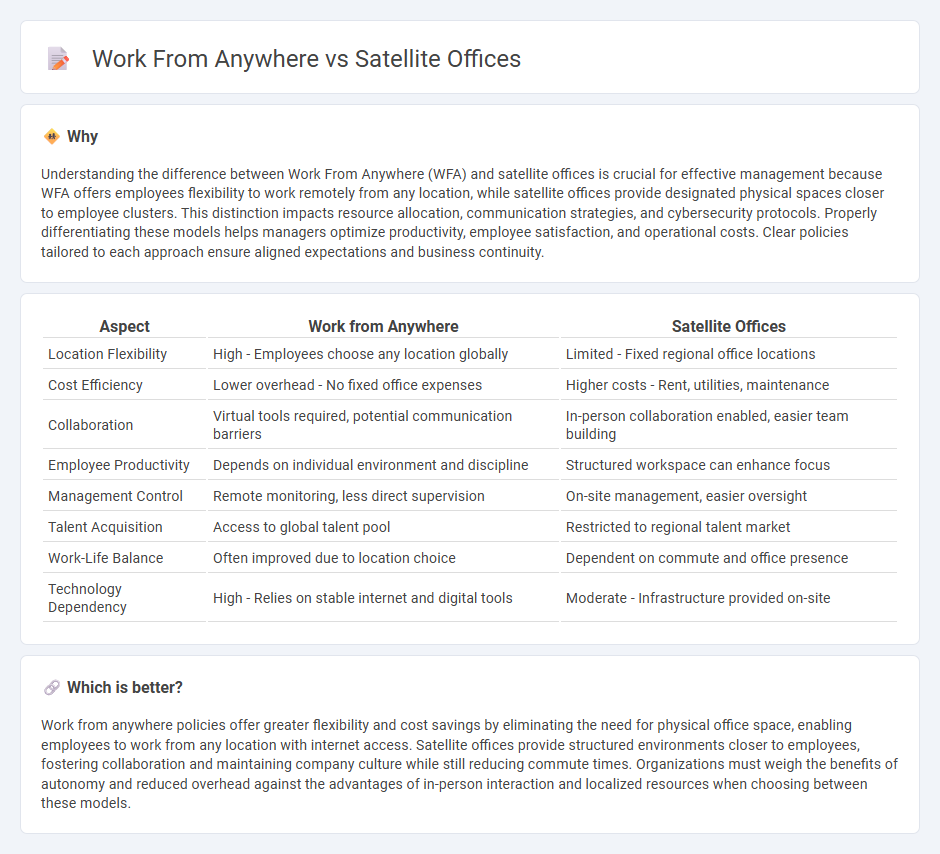
Work from anywhere (WFA) policies empower employees to operate remotely without geographical constraints, enhancing flexibility and talent reach. Satellite offices serve as decentralized physical hubs, maintaining local presence while supporting collaboration and company culture. Explore how integrating WFA and satellite offices can optimize workforce productivity and engagement.
Why it is important
Understanding the difference between Work From Anywhere (WFA) and satellite offices is crucial for effective management because WFA offers employees flexibility to work remotely from any location, while satellite offices provide designated physical spaces closer to employee clusters. This distinction impacts resource allocation, communication strategies, and cybersecurity protocols. Properly differentiating these models helps managers optimize productivity, employee satisfaction, and operational costs. Clear policies tailored to each approach ensure aligned expectations and business continuity.
Comparison Table
| Aspect | Work from Anywhere | Satellite Offices |
|---|---|---|
| Location Flexibility | High - Employees choose any location globally | Limited - Fixed regional office locations |
| Cost Efficiency | Lower overhead - No fixed office expenses | Higher costs - Rent, utilities, maintenance |
| Collaboration | Virtual tools required, potential communication barriers | In-person collaboration enabled, easier team building |
| Employee Productivity | Depends on individual environment and discipline | Structured workspace can enhance focus |
| Management Control | Remote monitoring, less direct supervision | On-site management, easier oversight |
| Talent Acquisition | Access to global talent pool | Restricted to regional talent market |
| Work-Life Balance | Often improved due to location choice | Dependent on commute and office presence |
| Technology Dependency | High - Relies on stable internet and digital tools | Moderate - Infrastructure provided on-site |
Which is better?
Work from anywhere policies offer greater flexibility and cost savings by eliminating the need for physical office space, enabling employees to work from any location with internet access. Satellite offices provide structured environments closer to employees, fostering collaboration and maintaining company culture while still reducing commute times. Organizations must weigh the benefits of autonomy and reduced overhead against the advantages of in-person interaction and localized resources when choosing between these models.
Connection
Work from anywhere policies enhance organizational flexibility by enabling employees to operate outside traditional headquarters, which directly supports the expansion of satellite offices as localized hubs. Satellite offices provide strategic locations that maintain team cohesion and culture while leveraging remote work benefits, such as reduced commute times and access to diverse talent pools. This synergy between decentralized work environments and satellite office networks drives improved productivity and operational resilience across global markets.
Key Terms
Decentralization
Decentralization in modern workplaces emphasizes distributing operations across satellite offices and adopting work-from-anywhere policies to enhance flexibility and reduce centralized office dependence. Satellite offices provide localized hubs that support regional collaboration and customer engagement, while work-from-anywhere models empower employees to operate remotely without geographic constraints. Explore the strategic benefits and challenges of these decentralized work approaches to optimize your organizational design.
Flexibility
Satellite offices provide employees with designated workspaces closer to home, offering structure while reducing commute times and enhancing work-life balance. Work from anywhere policies maximize flexibility by allowing employees to choose any location for work, promoting autonomy and adaptability across diverse environments. Explore the advantages and challenges of each approach to determine the best flexibility solution for your organization.
Supervision
Satellite offices offer structured environments that enhance direct supervision and immediate team collaboration, fostering higher productivity and clearer communication channels. Work from anywhere models rely heavily on digital tools and trust-based management, which can challenge real-time supervision but promote flexibility and autonomy. Explore how businesses balance supervision needs with operational flexibility to optimize team performance.
Source and External Links
What is a satellite office? - A satellite office is a branch of a company that is physically separate from its main office, offering flexible working solutions and expansion opportunities.
What Is a Satellite Office? Everything You Need to Know - Satellite offices help companies expand into new geographical locations, providing independent operations and access to new markets.
What Is a Satellite Office? (With Benefits and Tips) - Satellite offices offer benefits such as increased productivity, improved customer interaction, and decreased operational costs for businesses.
 dowidth.com
dowidth.com